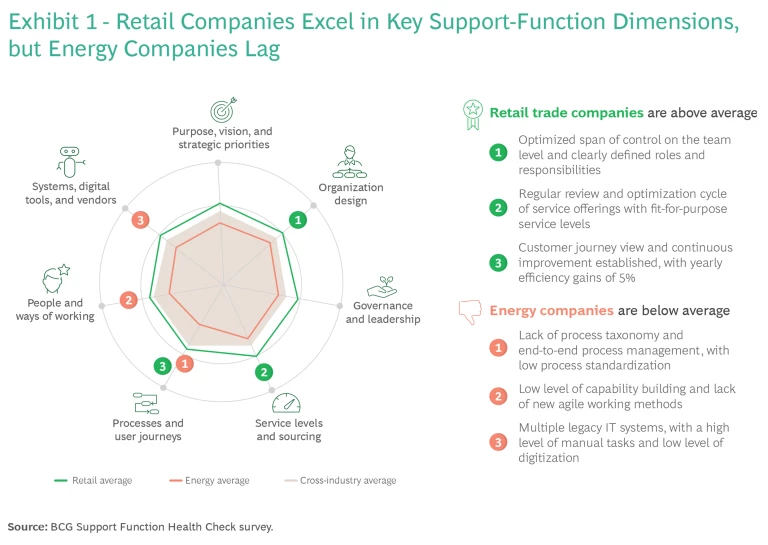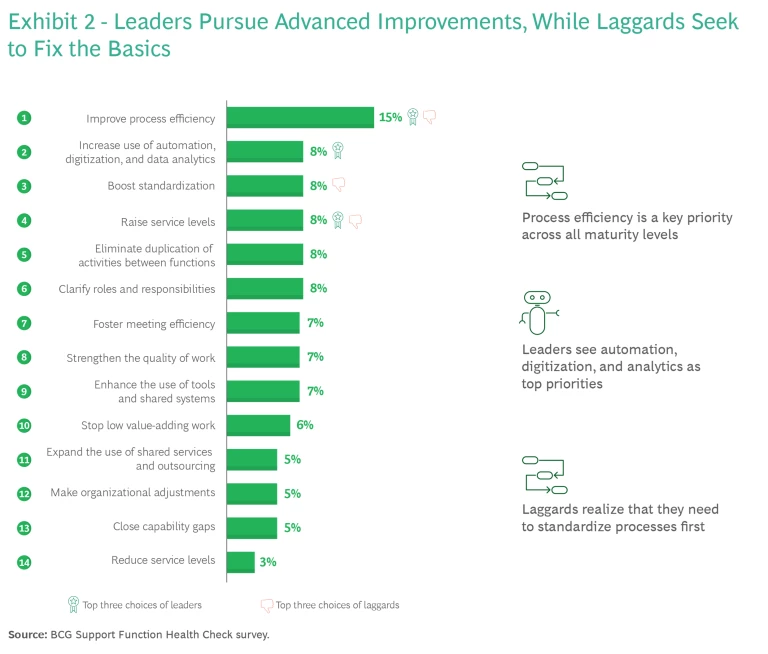Support functions, often considered the backbone of corporate efficiency, can play a vital role in shaping a company’s culture, operations, and adaptability. Even so, a BCG study found that only about one in five companies have high-performing support functions, with a substantial gap between the best and worst performers.
Our examination of the characteristics that set leaders apart uncovered three pivotal insights for companies that aim to elevate their support functions. By looking beyond their industry to find role models, understanding customers’ needs, and getting the basics right before digitizing, companies can enhance their functions’ performance and cost efficiency. Whether through a targeted or holistic effort, these approaches provide a pathway for meaningful transformation.
A Broad Spectrum of Performance
Companies must meet a variety of ongoing challenges—such as transitioning to remote work, adapting to disruptions, and adopting digital technology—all while curbing expenditures. Support functions provide many of the capabilities that businesses must deploy to meet the continual imperative to do more with less.
Support functions provide many of the capabilities that businesses must deploy to meet the continual imperative to do more with less.
Excellent functions deliver efficiency, experience, and value . They achieve efficiency by scaling resources and quickly responding to disruptions. They use customer feedback and best practices for online experiences to offer top-notch service while adapting to changing customer needs. They also apply a deep understanding of customers and employees to launch new initiatives that create more value. But many support functions are not performing at this higher level.
Where do low-performing support functions fall short and how can they improve? To find the answers, we surveyed managers from more than 200 companies across the globe and in all major industries. We assessed the maturity of these organizations’ support functions on the basis of 27 parameters within seven dimensions:
- Purpose, vision, and strategic priorities
- Organization design
- Governance and leadership
- Service levels and sourcing
- Processes and user journeys
- People and ways of working
- Systems, digital tools, and vendors
Our survey results reveal a wide range of performance.
Notably, only 20% of survey respondents rated their support functions as highly mature. These companies (which we categorize as “leaders”) scored exceedingly well across most or all dimensions. For example, a European automotive firm demonstrated greatly standardized and harmonized business processes throughout all support functions. Its process design is customer centric, ensuring that internal customers are neither over- nor underserved. Moreover, the company has successfully integrated major IT systems and complementary external software-as-a-service solutions, allowing for automated execution and informed decision making.
Approximately 50% of the respondents indicated that their companies’ support functions exhibit maturity in various areas and that management actively drives improvements with the wider involvement of employees. Yet these organizations have not taken the final steps needed to break out of the pack and join the ranks of the leaders. For instance, a US-based financial institution excels in purpose, vision, and strategic priorities, which are well articulated, communicated, and understood by employees. But the company lags in organization design, with a siloed structure that fails to support business needs. It also struggles with governance and leadership, owing to a lack of clear ownership, responsibilities, and leadership behaviors.
The remaining 30% of respondents assessed their support functions as exhibiting low maturity and not being set up to provide adequate support to the business. These support functions scored below average in most dimensions. We refer to them as “laggards.”
Three Key Insights
The study yielded three essential takeaways for companies aiming to enhance their support functions.
Look Beyond Your Industry to Find the Leaders
Businesses establishing goals for their support functions should not confine their benchmarking to direct industry competitors. In most instances, they will find more appropriate role models in other sectors. Many successful practices—such as those in human resource management, automation, or ways of working—apply to support functions across various industries.
Three of the industries we studied—retail trade, construction, and automotive—stand out as having the largest share of leaders. Companies in these highly competitive industries have operated with relatively low margins and, for many years, focused on reducing costs to competitively low levels. Because these organizations were forced to scrutinize every dollar spent, they have often undergone multiple rounds of optimization. Through relentless efforts to achieve the highest degree of standardization and automation, their support functions have attained a higher level of maturity than is typically seen in other industries. But even companies in these leading industries still have room for improvement.
Know What Your Customers Need and Deliver It
In general, the leaders cultivate closer relationships with their internal and external customers and develop a keen understanding of their genuine needs and priorities. Armed with this knowledge, support function teams can focus their efforts on creating value, rather than expending time on nonessential tasks.
Furthermore, leaders possess the capability to effectively deliver services thanks to optimized end-to-end processes and cross-functional collaboration, which cut across traditional organization silos. Flat hierarchies empower employees and streamline communication.
Conversely, laggards contend with inefficiencies in their business processes and user journeys, which impede the optimal delivery of support function services. Although these organizations allocate more resources to support functions, bureaucratic procedures and excessive workloads hinder service provision. Companies can address these deficiencies by moving up the maturity curve.
High-performing support functions apply their strong knowledge of customers to excel in three dimensions:
- Organization Design. Implementing well-defined roles and responsibilities along with flat organization hierarchies.
- Service Levels and Sourcing. Tailoring service levels to fit the purpose and establishing a clear sourcing strategy.
- Processes and User Journeys. Developing transparent business processes and customer journeys, which are subject to continuous improvement.
As shown in Exhibit 1, retail trade companies perform above average in these dimensions, while energy companies struggle in these and other areas.

Get the Basics Right Before Digitizing
Companies aspiring to elevate their support functions’ maturity should initially focus on simplifying their organizations, processes, and services. By laying this foundation, they will be positioned to reap the benefits of digital support functions.
Respondents identified process efficiency, digitization and automation, and standardization as their priority levers for improving support functions. In addition, the respondents agreed that a rise in service levels is important, yet secondary. A notable difference emerges when we analyze the responses of the laggards and leaders separately. (See Exhibit 2.)

Laggards expressed an urgent need to standardize operations, enhance processes, clarify roles and responsibilities, and increase the use of tools. This suggests these companies are grappling with significant operational complexity that must be addressed and streamlined.
In contrast, leaders have already tackled the basics. They are now directing their attention toward digitization, automation, and data analytics in their support functions. This emphasis on digital technologies and data reflects an aspiration to create higher value, enrich the customer experience, and generate cost efficiencies.
Embarking on Your Journey
There are two potential paths to develop a support function that is both efficient and effective and adds value across the company.
A Targeted Approach. For a focused effort, concentrate on step change improvements in one of the seven maturity dimensions, such as processes and user journeys. Customize the approach to address the most significant pain points in one or several functions. To boost efficiency, conduct a zero-based review to identify and eliminate low-value services and resources. Assess ways to further reduce costs by leveraging technology or sourcing more cost-effectively, such as through outsourcing or relocating services to low-cost countries. To increase effectiveness and improve process outcomes, evaluate and adapt processes from end to end by considering their value from the perspective of end users, not internal functions.
A Holistic Approach. For a more comprehensive path, overhaul the entire operating model of some or all support functions within the scope of the transformation. The objective is to fully reevaluate the current model and apply the insights to establish a new operating model. Considering strategic business requirements, develop each support function’s value-adding setup across the seven maturity dimensions. For each function, establish a small team of top managers to draft a blueprint for its transformation. The team then engages with the next lower management level to ensure these managers’ support for the transformation and empower them to implement it. Ultimately, the team sets out the new functional organization structure in detail and plans the implementation.
By achieving high maturity in support functions, a company enhances its prospects for successfully navigating the business challenges that lie ahead. Yet delivering high performance is not easy, and many support functions are struggling in multiple dimensions. The good news is that even low-performing support functions can elevate their performance by implementing a few deliberate changes. Reaching a higher, value-adding level of support function maturity is not a distant vision but a tangible goal that can be achieved with purposeful action.








